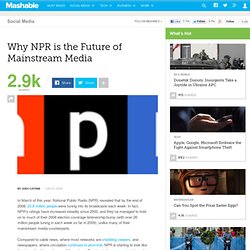

Sosiale og mobile teknologier i ABM-sektorene. What is Web 3.0? Semantic Web & other Web 3.0 Concepts Expla. Web 3.0 will be about semantic web, personalization (e.g. iGoogle), intelligent search and behavioral advertising among other things. This slide neatly sums up the main differences between Web 1.0, Web 2.0 and Web 3.0. Web 1.0 – That Geocities & Hotmail era was all about read-only content and static HTML websites. People preferred navigating the web through link directories of Yahoo! And dmoz. Web 2.0 – This is about user-generated content and the read-write web. Web 3.0 – This will be about semantic web (or the meaning of data), personalization (e.g. iGoogle), intelligent search and behavioral advertising among other things.
Why NPR is the Future of Mainstream Media. In March of this year, National Public Radio (NPR) revealed that by the end of 2008, 23.6 million people were tuning into its broadcasts each week.

In fact, NPR's ratings have increased steadily since 2000, and they've managed to hold on to much of their 2008 election coverage listenership bump (with over 26 million people tuning in each week so far in 2009), unlike many of their mainstream media counterparts. Compared to cable news, where most networks are shedding viewers, and newspapers, where circulation continues to plummet, NPR is starting to look like they have the future of news all figured out.
Or at least, they appear to doing a lot better at it than the rest of the traditional media. But what is NPR doing differently that's causing their listener numbers to swell? A Focus On Local Focusing on local information is a very smart approach for two reasons. "Despite globalization, hyperlocal information is very valuable both to people and advertisers. A Focus On Social Media. Get the Most Out of FriendFeed. Wendy Boswell stays on top of Web search and social media trends at About.com. You can catch up with her via Twitter. FriendFeed is a social media feed aggregator that makes it easy to follow many different individuals’ various social activities on the Web all in one convenient place, instead of jumping from service to service (and having to create new accounts ad infinitum!) To see what the people you’re most interested in are doing. It’s basically a continuous river of information that you can use as a virtual water cooler of news and content, but it’s also interactive – you’re encouraged to comment on other people’s stories, “like” something that resonates with you, and more.
If you’re looking for something that is a one-stop solution for a variety of different content frames: feed readers, micro-blogging, images, etc, then FriendFeed is a good fit. Let’s look at a few tips for both beginning and more advanced FriendFeed users that can help you make this service as useful as possible.